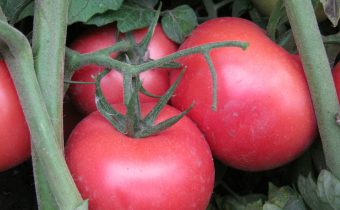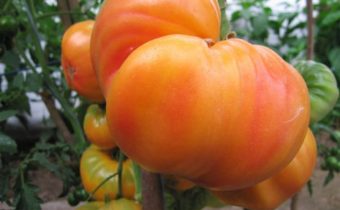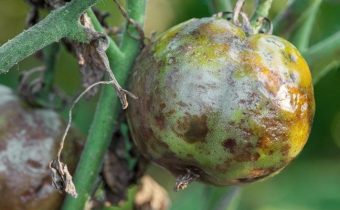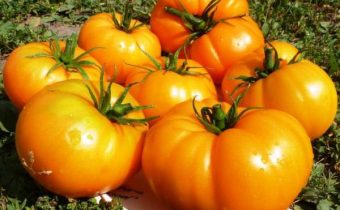Features growing tomato "Red Guard"
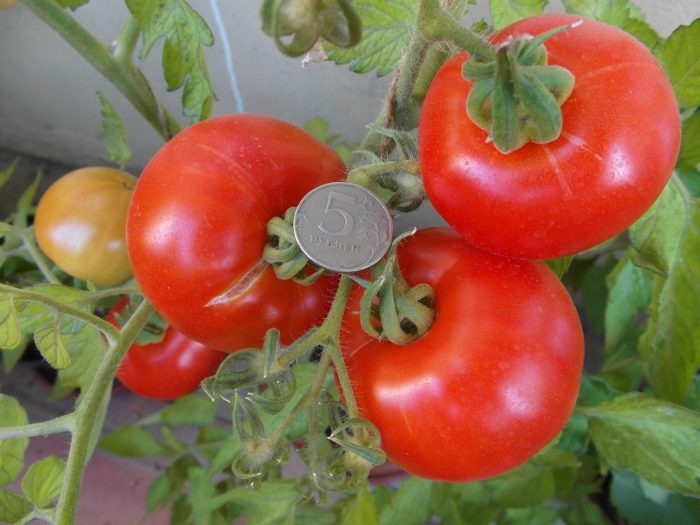
general information
The tomato variety “Krasnaya Gvardiya” was created by the Russian breeders of the Chelyabinsk seed-growing station in 2012, intended for planting in the middle belt, the Ural and Siberian regions, where there is a short and unpredictable summer.
This very young tomato Red Guard, judging by the reviews and photos, who planted, stands out among the other hybrids for its parameters:
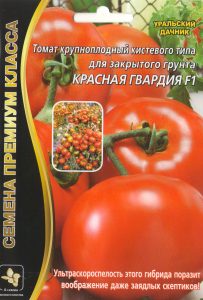
- first-generation super determinant hybrid;
- early maturing, only 90 days from germination to maturity;
- resistant to low temperatures and low light;
- high yield (from 2.5 to 5 kg per bush);
- ripen in adverse conditions;
- transportable;
- can be stored for about three weeks;
- increased sugar content and flavor;
- universal purpose;
- for growing in greenhouses and temporary shelters.
Let's take a closer look at the Red Guard tomato. Characteristics and description of the variety are given below.
Characteristics and description
Description of the bush
 Tomatoes "Red Guard" refers to the superdeterminant type, that is, independently ends growth after the fifth hand. The height of the bush, as manufacturers say, is 70‒80 cm, but it can reach 1–1.2 meters, depending on the place of growth.
Tomatoes "Red Guard" refers to the superdeterminant type, that is, independently ends growth after the fifth hand. The height of the bush, as manufacturers say, is 70‒80 cm, but it can reach 1–1.2 meters, depending on the place of growth.
It is a compact bush of carpal type: that is, the fruits develop in clusters of up to nine pieces, ripening together and very early. They have time to give the harvest even in a short northern summer.
The bush is powerful, it is recommended to tie up so that it does not collapse under the weight of the crop.
Fruit Description
- Bright red, slightly flattened, rounded, rippled at the very stem, but poorly expressed;
- the pulp is dense, sugary, has a sweetish, revealed tomato flavor;
- fruits are medium, rather large, from 150 to 250 g, therefore they are good raw, in salads, and smaller ones are suitable for blanks. Because of its elasticity, it is possible to preserve in a cut form, and also to process into sauces, tomato paste, lecho and juices.
- well transported and stored for more than three weeks;
- not prone to cracking.
See also: How to feed tomato seedlings to be plump?
Disease and Pest Resistance
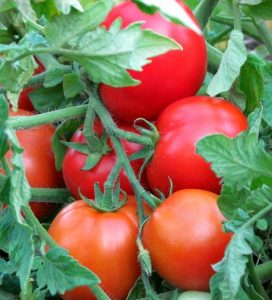 Tomato has a good immune system: it is not afraid of most common viruses, fungal diseases, and its precocity helps to avoid diseases that damage tomatoes in late summer.
Tomato has a good immune system: it is not afraid of most common viruses, fungal diseases, and its precocity helps to avoid diseases that damage tomatoes in late summer.
Tomato "Red Guard" f1 according to reviews of gardeners to pest racks, but as practice shows, the main enemy of its whitefly, therefore, the prevention of this pest must begin long before its appearance, that is, to prevent this trouble.
Properly grown seedlings are resistant to diseases, and pest control is better in advance by simple harmless methods, without resorting to chemicals that can be used only in extreme cases. "Actellic" and "Confidor" performed well.
The whitefly is afraid of garlic tincture: crush 150 g, add 1 l of water, leave for 5 days, strain and spray the plants every 5 days. To improve the action, add soap no less than 72%.
You may be interested in: Diseases of tomatoes in the greenhouse and their treatment
Advantages and disadvantages
Let's highlight all the pros and cons of the Red Guard tomato, the photo and description of which we have already reviewed.
The variety has many advantages:
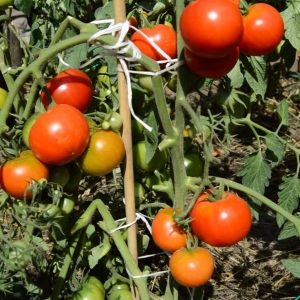
- A new-generation tomato, resistant to bad weather, can bear fruit in areas where it is difficult to grow a thermophilic tomato, and gardeners rarely see red fruits on a branch, always collecting green tomatoes. And this variety pleases mature fruits on the bush.
- Tomatoes have a sweet peculiar taste and aroma, which is also a distinctive feature and plus, as early ripe tomatoes are rarely sugar and sweet.
- The bush is strong, not high, does not require a high greenhouse and pasynkovaniya. It can bear fruit under temporary shelter or in open ground in the southern regions.
- Yielding, can give up to 5 kg from a bush with proper cultivation, ripen fruit amicably, beautiful-looking, strong, stored and transported beautifully.
- Virtually no illness due to high immunity, thereby facilitating the cultivation and care, which will cope even inexperienced summer resident.
Cons variety
If you remove the susceptibility of a variety to such a pest as a whitefly, and it can infect any plants, it is safe to say that the Red Guard has no flaws.
Features of growing varieties
It is easier to grow hybrid varieties, but in order to get that crop, which is declared by the breeders, you need to follow certain rules.
Before sowing the seeds are soaked in phytosporin solution, which helps to avoid disease and improve the growth of seedlings.
Since the variety is early ripening and determinant, the seedlings should be chunky, but for this it needs extra light.
In addition to lighting, mineral supplements are important. When picking seedlings, it is necessary to add superphosphate so that roots form more easily, and they are a guarantee of good growth.
The seedling of this variety, before planting in the ground, should have at least 6 листьев8 leaves and a short distance between them, a purple shade and one floral brush on the thick stem.
Planted seedlings are planted in a staggered manner at a distance of at least 60 cm. The distance in the greenhouse is increased to 80 cm, since it is important that the leaves do not touch, allowing light to penetrate from all sides.
Garter plants required! When planting at the root stick a strong count and a bottle for watering. The bottle is instilled with the open neck down, the bottom of the bottle is cut off.
Plants of limited growth do not require stading, but in order for the Red Guard tomato to fully reveal its qualities, it is necessary to cut off the stepsons to the third leaf, and form a shrub into 4 trunks. This is the best solution. If you leave only 2‒3 stem, the fruits will be larger.
Top dressing and watering
 When planting seedlings, 1 liter of humus is poured into the hole, 1 liter of ash, and 2 tablespoons of superphosphate. Watered with warm water for at least 5 liters and covered with a layer of peat, humus or straw, making the soil mulching.
When planting seedlings, 1 liter of humus is poured into the hole, 1 liter of ash, and 2 tablespoons of superphosphate. Watered with warm water for at least 5 liters and covered with a layer of peat, humus or straw, making the soil mulching.
Mulch retains moisture, does not allow the earth to become covered with a crust, regulates the temperature of the soil, helps plants in cold nights not to get sick, because if the roots are warm, then immunity is on top!
After planting the tomatoes in the ground for 7 days, they are not fed or watered. During this time, they are well rooted.
Further, top dressing is done every 15 days. You can use ready-made mineral fertilizers or use, if there is a desire and possibility, organic fertilizers. Many believe that they are more secure.
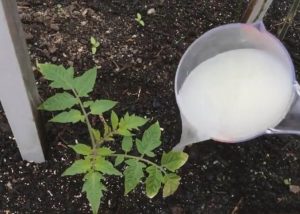 The first top dressing: after planting the seedlings is carried out after 7 days with nitrogen fertilizer or tincture of mullein: 1 liter is diluted in a bucket of water and watered at 1 liter under the root.
The first top dressing: after planting the seedlings is carried out after 7 days with nitrogen fertilizer or tincture of mullein: 1 liter is diluted in a bucket of water and watered at 1 liter under the root.
The second feeding: tincture of herbal mass, or as it is called gardeners "cocktail".
The tincture is made simple, and the benefits - a lot. Fold all the weeds into the tank, add 1 l of mullein and 1 l of soil, pour water over and insist for a week.Two liters of infusion diluted in a bucket of water, water all the plants in 1 liter at the root.
The third dressing: yeast. At 4 liters of warm water pour a pack of dry yeast and 10 tablespoons of sugar. After 4 hours, pour into a bucket with six liters of water. Water 1 liter at the root.
When the ovaries appear on all hands, the tomatoes are fed 1 liter of potash fertilizer for the plant. This ash, diluted 2 liters per bucket of water. Such dressings are done 2 times in 15 days.
See also: The best varieties of tomatoes for open ground
As soon as the tomatoes begin to blush and the majority get browned, stop feeding all of them! Limit watering 3 times, otherwise the fruits will be watery and may crack.
Watering during the entire growth of tomatoes is rarely needed: once every 7 days! More often it is impossible. Watering to produce warm water, at least 5 liters under one plant. After watering the mandatory ventilation of the greenhouse or shelter.
If you follow these simple rules, then the variety “Red Guard” tomato will exactly justify its name, and expectations, and will break all the yield records.
Video: High yield tomato, effortless:



